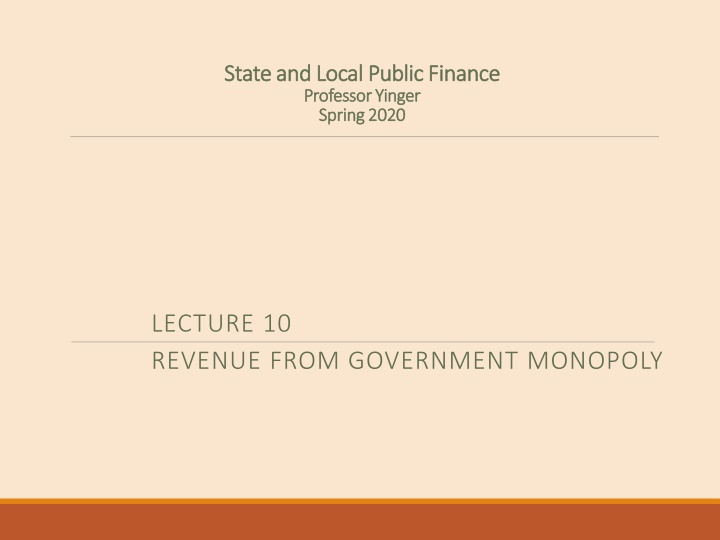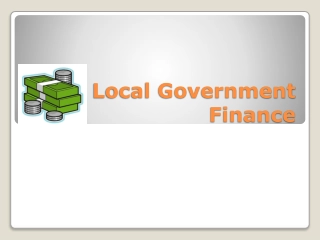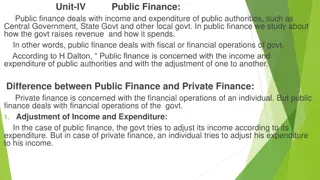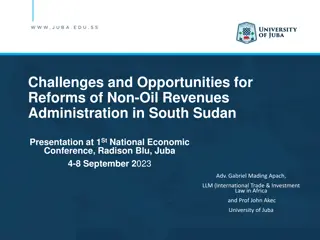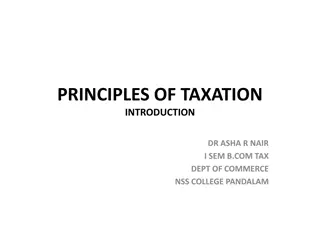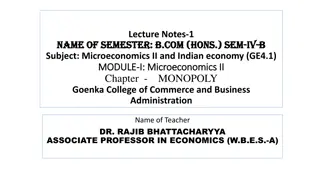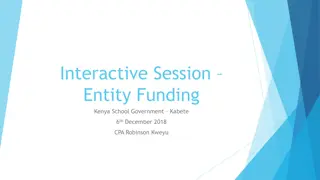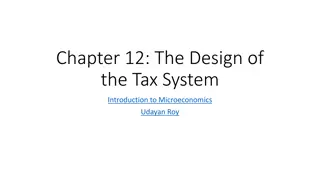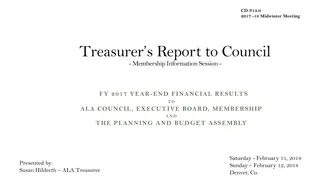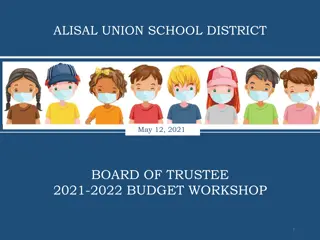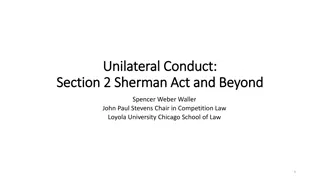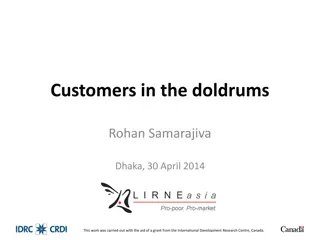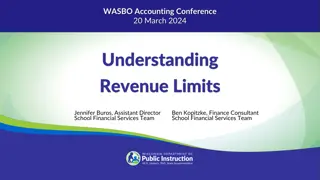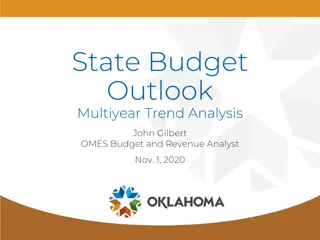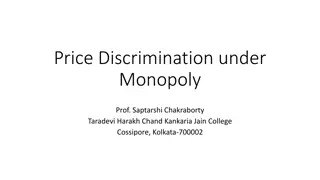Revenue from Government Monopoly in Public Finance
Explore why government monopolies exist, such as state-run liquor stores and lotteries, and the impact on revenue generation. Discover the trade-offs between maximizing revenue and consumer surplus in monopoly pricing.
Download Presentation

Please find below an Image/Link to download the presentation.
The content on the website is provided AS IS for your information and personal use only. It may not be sold, licensed, or shared on other websites without obtaining consent from the author.If you encounter any issues during the download, it is possible that the publisher has removed the file from their server.
You are allowed to download the files provided on this website for personal or commercial use, subject to the condition that they are used lawfully. All files are the property of their respective owners.
The content on the website is provided AS IS for your information and personal use only. It may not be sold, licensed, or shared on other websites without obtaining consent from the author.
E N D
Presentation Transcript
State and Local Public Finance State and Local Public Finance Professor Yinger Professor Yinger Spring Spring 2020 2020 LECTURE 10 REVENUE FROM GOVERNMENT MONOPOLY
State and Local Public Finance State and Local Public Finance Lecture 10: Lecture 10: R Revenue from Government Monopoly evenue from Government Monopoly Class Outline Why Have Government Monopolies? State-Run Liquor Stores State-Run Lotteries
State and Local Public Finance State and Local Public Finance Lecture 10: Lecture 10: R Revenue from Government Monopoly evenue from Government Monopoly Why Government Monopoly? Reason 1: Natural Monopoly A declining long-run AC curve gives large firms a competitive advantage and leads to monopoly. Unregulated private monopolies select inefficient levels of output. So governments either: o Regulate private monopoly or o Set up a government monopoly
State and Local Public Finance State and Local Public Finance Lecture 10: Lecture 10: R Revenue from Government Monopoly evenue from Government Monopoly P MR D=MB Pmon Peven AC Peff MC Q Government monopoly can raise revenue by setting price anywhere between the break-even price (Peven) and the private monopoly price (Pmon). It loses money at the efficient price (Peff).
State and Local Public Finance State and Local Public Finance Lecture 10: Lecture 10: R Revenue from Government Monopoly evenue from Government Monopoly Monopoly Pricing, 2 If the government monopoly uses the private monopoly price it: o Maximizes its revenue o Causes the same distortion as the private monopoly! o Transforms monopoly profits into government revenue. Even at the monopoly price, consumer surplus (CS) is generated, but there is a clear trade-off between CS and government revenue.
State and Local Public Finance State and Local Public Finance Lecture 10: Lecture 10: R Revenue from Government Monopoly evenue from Government Monopoly Monopoly Pricing, 3 If the government sets the efficient price, it o Maximizes consumer surplus in this market, o But it loses money o And must raise revenue elsewhere, undoubtedly causing distortion (i.e. lost consumer surplus) in other markets. We will pursue these issues in a later class.
State and Local Public Finance State and Local Public Finance Lecture 10: Lecture 10: R Revenue from Government Monopoly evenue from Government Monopoly Why Government Monopoly? Reason 2: Regulation Governments sometimes decide to monopolize a good or service on policy grounds. Hence they prohibit private production and provide the product themselves. This case involves the same trade-off between CS and government revenue.
State and Local Public Finance State and Local Public Finance Lecture 10: Lecture 10: R Revenue from Government Monopoly evenue from Government Monopoly Monopoly Pricing, 4 P MR D=MB Pmon Peff =Peven AC = MC Q Government monopoly can raise revenue by setting price anywhere between the break- even price (Peven), which is the efficient price (Peff), and the private monopoly price (Pmon).
State and Local Public Finance State and Local Public Finance Lecture 10: Lecture 10: R Revenue from Government Monopoly evenue from Government Monopoly State-Run Liquor Stores According to the Census, 16 states have a state-run liquor monopoly, sometimes at the wholesale level, sometimes for both wholesale and retail. This reflects the prohibition tradition in some states not a natural monopoly. It gives the state control over advertising and sales. It boosts exporting because a state can charge a high price to non- residents even if it cannot tax them.
State and Local Public Finance State and Local Public Finance Lecture 10: Lecture 10: R Revenue from Government Monopoly evenue from Government Monopoly State-Sponsored Gambling All states except Hawaii and Utah collect revenue from one or more forms of gambling. In Alaska, gambling operations are legal only on Indian reservations. In May 2019, 43 states allowed pari-mutuel betting, 45 states had legalized lotteries, 20 states had legalized commercial casino operations, and 12 states had racinos (hybrids of casinos and racetracks). In addition to Alaska, Native American casinos are legal in 28 additional states that also have some other type of sanctioned gambling activity. Source: Dadayan (NTJ, December 2019).
State and Local Public Finance State and Local Public Finance Lecture 10: Lecture 10: R Revenue from Government Monopoly evenue from Government Monopoly State-Sponsored Gambling, 2 Revenue from lotteries, casinos, racinos, video gaming machines, and pari-mutuels is a minor source of funding for most states. In FY 2017, state and local governments collected $29.5 billion from major types of gambling. About 64.1% came from lottery operations, 30.5% from casinos and racinos, 5% from video games, and 0.4% from pari-mutuel wagering. States can also raise revenue from Indian casinos through negotiated revenue-sharing agreements with the tribes (but data are not available). In fiscal year 2017, gambling revenue from major sources represented 2.2 percent of total state own-source general revenues. In 33 of the 47 states that have gambling operations, gambling revenue represented less than 3% of state own source general revenues, and in another five states, it was less than 5% of state revenue. Louisiana, Nevada, Rhode Island, and West Virginia had much higher reliance on gambling revenue, especially from casinos and racinos. Source: Dadayan (NTJ, December 2019).
State and Local Public Finance State and Local Public Finance Lecture 10: Lecture 10: R Revenue from Government Monopoly evenue from Government Monopoly State-Sponsored Gambling, 3 Today we focus on lotteries. Some other forms of gambling are considered in the next class on sin taxes, including: Casinos Racinos (combinations of casinos and race tracks) Pari-mutuel betting (in which the odds depend on the amount of betting; often used for horse and dog racing) Sports betting
State and Local Public Finance State and Local Public Finance Lecture 10: Lecture 10: R Revenue from Government Monopoly evenue from Government Monopoly State-Run Lotteries The first state lottery was in New Hampshire in 1964. Now 45 states have a lottery. In FY 2017, lotteries raises about 1.5% of general state revenue in the average state. Lotteries probably are a natural monopoly, as customers are attracted to very large prizes. For more on lotteries, see http://rockinst.org/wp-content/uploads/2017/11/2016-04-12- Blinken_Report_Three-min.pdf
State and Local Public Finance State and Local Public Finance Lecture 10: Lecture 10: R Revenue from Government Monopoly evenue from Government Monopoly Policy Issues Raised By Lotteries 1. Legalization (Should lottery gambling be allowed?) 2. Government Provision (Should lotteries be a private or government monopoly?) 3. Rate of Taxation (How much revenue should the state claim?) 4. Earmarking (Should the revenue be earmarked for education?) 5. Promotion (How should lotteries be designed and advertised?)
State and Local Public Finance State and Local Public Finance Lecture 10: Lecture 10: R Revenue from Government Monopoly evenue from Government Monopoly Legalization Lotteries generate consumer surplus, that is, many people pay for their entertainment value. Lotteries also generate social costs: gambling addiction for some people, increased crime, and, perhaps, undermining incentives to earn one s way. There is a consensus in this country that the benefits outweigh the costs (although the costs are high).
State and Local Public Finance State and Local Public Finance Lecture 10: Lecture 10: R Revenue from Government Monopoly evenue from Government Monopoly Government Provision Lotteries require large scale, so private lotteries would be huge companies that would be: o Difficult to regulate and tax (think of their political connections!) o Inviting to criminal elements. Thus, there is a broad consensus that legalized lotteries should be government monopolies. But many states are debating private management or even the sale of the lottery to a private company.
State and Local Public Finance State and Local Public Finance Lecture 10: Lecture 10: R Revenue from Government Monopoly evenue from Government Monopoly Government Provision, 2 In January 2011, Illinois turned the management of its lottery over to a private firm. Indiana and New Jersey have also gone this route. In Illinois, the firm agreed to large payments to the state if it does not increase lottery revenue. Without comprehensive contracts, this approach is a recipe for exploitation.
State and Local Public Finance State and Local Public Finance Lecture 10: Lecture 10: R Revenue from Government Monopoly evenue from Government Monopoly Government Provision, 3 Some early commentary worried about revenue shortfalls. A former governor of Massachusetts said: o Illinois appears to be ending its experiment nearly half a billion dollars behind the revenue projections promised by the winning bidder and with no truly game-changing innovations in the way the lottery performs. New Jersey missed on already-lowered revenue projections last year, and is running further behind this year. Indiana was viewed as a relative success , but the private operator missed its targets last year, too and the Hoosier Lottery is now on track to miss its 2015 targets by $50 million. See http://www.forbes.com/sites/realspin/2015/02/24/where-lottery- privatization-went-wrong/#466a94214f18 .
State and Local Public Finance State and Local Public Finance Lecture 10: Lecture 10: R Revenue from Government Monopoly evenue from Government Monopoly Government Provision, 4 But now the private management firm in Illinois is bragging about increases in revenue (=more exploitation?): o "We couldn't have achieved this unprecedented milestone for Illinois without our enthusiastic players and hardworking retailers," said Colin Hadden, General Manager for Camelot Illinois, which is the Illinois Lottery s private manager. "We are thrilled our partnership with the State is generating excitement for the Lottery across Illinois and - most importantly creating meaningful returns for public education and other special causes. See https://www.world-lotteries.org/media-news/member- news/2848-illinois-lottery-reports-record-breaking-sales-for-october .
State and Local Public Finance State and Local Public Finance Lecture 10: Lecture 10: R Revenue from Government Monopoly evenue from Government Monopoly Government Provision, 5 The situation is even more troubling in New Jersey: o The state has renegotiated a contract with the private operator of the New Jersey Lottery that is expected to save taxpayers up to $100 million over the next decade. o The new agreement raises the performance targets for Northstar New Jersey, a gaming conglomerate that has struggled to meet its financial promises to the state while reaping tens of millions of dollars each year in incentives and fees. It had promised to generate "at least" $1.4 billion for the state over the life of the contract, which expires in 2029. o But those financial ambitions were drastically curtailed amid slumping sales of the popular games Powerball and Mega Millions, primarily due to what the lottery called "jackpot fatigue." o The previous administration slashed the company's total promised income to the state by $1 billion because of the sales declines and because the state had denied Northstar the ability to launch keno-style games, limiting its ability to generate sales. o But then it reversed course and Northstar launched Quick Draw in 2017, a game so widespread that it can be played at Garden State Parkway rest stops. Powerball and Mega Millions have rebounded, seeing record jackpots in recent years, but Quick Draw has had trouble meeting its goals, falling $1 million behind targets a week earlier this year. See https://www.northjersey.com/story/news/new-jersey/2019/05/14/nj-lottery-deal-northstar- new-jersey-save-taxpayers-100-m/3663943002/
State and Local Public Finance State and Local Public Finance Lecture 10: Lecture 10: R Revenue from Government Monopoly evenue from Government Monopoly Rate of Taxation Lotteries provide a classic example of the trade-off between CS and revenue: o The analytical case for lotteries is based on the CS they generate, which is minimized by low implicit tax rates. o The political case for lotteries is based on the money they raise, which is maximized by high implicit tax rate.
State and Local Public Finance State and Local Public Finance Lecture 10: Lecture 10: R Revenue from Government Monopoly evenue from Government Monopoly Rate of Taxation, 2 In this case (as in many others!) politics wins, that is, the implicit tax rates are very high. What is the implicit tax rate? o Answer: What the state keeps divided by the total costs of running the lottery. o Let t= implicit tax rate, R = state revenue, P = prizes awarded, C = administrative costs. R + = t Then P C
State and Local Public Finance State and Local Public Finance Lecture 10: Lecture 10: R Revenue from Government Monopoly evenue from Government Monopoly Rate of Taxation, 3 According to the Census, the values of these variables for the U.S. as a whole in 2016 (per $1.00 of sales) are: o R = $0.315 o P = $0.640 o C = $0.045. Thus the average implicit tax rate in the U.S. in 2016 was: 0.315 0.640 0.045 + t = = = 0.461 46.1% This is analogous to a sales tax rate.
State and Local Public Finance State and Local Public Finance Lecture 10: Lecture 10: R Revenue from Government Monopoly evenue from Government Monopoly Rate of Taxation, 4 This is not a typo: The tax rate in the typical state was 46.1%! In 2016, implicit lottery tax rates range from 16% (Idaho) to 288% (South Dakota) and are all far higher than the rates for any other type of sales tax. These high rates of tax cause enormous distortion between lotteries and other types of commodities. But they also cut back on the social costs (externalities) of lotteries and export taxes to nonresidents.
Implicit Lottery Tax Rates, 2016 26.8% Nebraska Arkansas 25.6% California 46.1% Colorado 34.6% Connecticut 44.4% Delaware 150.6% Florida 42.0% Georgia 37.5% Idaho 16.0% Illinois 33.6% Indiana 33.1% Iowa 31.8% Kansas 40.1% Kentucky 38.2% Louisiana 59.2% Maine 49.3% Maryland 43.9% Massachusetts 32.7% Michigan 42.6% Minnesota 36.5% Missouri 37.1% Montana 47.9% 35.1% 37.6% 47.1% 45.1% 66.2% 39.8% 40.0% 42.6% 57.6% 192.3% 42.2% 213.8% 36.9% 288.1% 66.8% 41.3% 29.5% 45.3% 37.8% 85.7% 49.3% 23.9% Arizona New Hampshire New Jersey New Mexico New York North Carolina North Dakota Ohio Oklahoma Oregon Pennsylvania Rhode Island South Carolina South Dakota Tennessee Texas Vermont Virginia Washington West Virginia Wisconsin Wyoming Source: U.S. Census
State and Local Public Finance State and Local Public Finance Lecture 10: Lecture 10: R Revenue from Government Monopoly evenue from Government Monopoly Rate of Taxation, 5 Moreover, lottery taxes are very regressive far more regressive than any other revenue source. One study: Low-income individuals earn 11% of total income but provide 25% of lottery revenue. Some games, such as instant games and lotto, are particularly regressive. Within income classes, the burden of lotteries is concentrated on a relatively small share of individuals.
State and Local Public Finance State and Local Public Finance Lecture 10: Lecture 10: R Revenue from Government Monopoly evenue from Government Monopoly Rate of Taxation, 6 So far we have discussed implicit taxes on lottery tickets. There are also income taxes on lottery winnings. Suppose 80% of the tickets for a state s lottery are sold to state residents and that there is a state income tax rate of 10%. Then, using the national average figures, the value of state revenue per dollar of ticket sales (R) goes up by (0.64)*(0.8)*(0.1) = 0.512. And the value of prizes (P) goes down by the same amount. Hence the implicit tax is (0.315 + 0.512) divided by (0.64 - 0.512 + 0.045) = 0.5778. This is an implicit rate of 58% instead of 46%.
State and Local Public Finance State and Local Public Finance Lecture 10: Lecture 10: R Revenue from Government Monopoly evenue from Government Monopoly Earmarking Almost half of lottery states earmark the funds for education. This link is part of their political appeal: Whatever their bad features, at least lotteries help fund our education system! It is not clear, however, that lotteries increase net funds for education: o They facilitate cuts in state education aid; o They lower sales tax revenue. Even counting benefits from education, lotteries are still regressive.
State and Local Public Finance State and Local Public Finance Lecture 10: Lecture 10: R Revenue from Government Monopoly evenue from Government Monopoly Earmarking, 2 For recent evidence on this issue see: Bell, Wehde, and Stucky (Education Finance and Policy, Winter 2020), who find that lottery earmark policies are associated with a 5 percent increase in higher education appropriations, and a 135 percent increase in merit-based financial aid. However, lottery earmarks are also associated with a decrease in need-based financial aid of approximately 12 percent. An accessible summary of this article can be found at: https://www.brookings.edu/blog/brown-center- chalkboard/2018/05/09/who-wins-and-who-loses-when-states-earmark- lottery-revenue-for-higher-education/
State and Local Public Finance State and Local Public Finance Lecture 10: Lecture 10: R Revenue from Government Monopoly evenue from Government Monopoly Promotion, 1 The people who run lotteries are paid to raise as much money as possible. Hence they resort to aggressive advertising: All you need is a dollar and a dream. Some of this advertising is misleading at best, with no recognition of the low odds of winning. Moreover, this advertising puts government in the position of undermining the work ethic.
State and Local Public Finance State and Local Public Finance Lecture 10: Lecture 10: R Revenue from Government Monopoly evenue from Government Monopoly Promotion, 2 The people who run lotteries sometimes resort to promoting games that are directed toward low-income communities. o These games maximize revenue because these people are more vulnerable to the misleading appeal of instant wealth. o But they also maximize both the regressivity of the lottery tax and the social costs of lottery addiction. Promotions of this type are, in my view, simply unethical.
State and Local Public Finance State and Local Public Finance Lecture 10: Lecture 10: R Revenue from Government Monopoly evenue from Government Monopoly Promotion, 3 Quick Draw is a game played in bars and some stores in NY. Governor Cuomo has proposed expanding the set of places to play and lowering age limits. The restrictions have proved cumbersome and unnecessary, and have substantially reduced the amount of earnings that would otherwise be generated by the game. So let s get more kids hooked on video gambling to raise a few $s?
State and Local Public Finance State and Local Public Finance Lecture 10: Lecture 10: R Revenue from Government Monopoly evenue from Government Monopoly Promotion, 4 Illinois, Indiana, and New Jersey employ private companies to manage their lotteries; other states are considering this step. Private management is seen as a way to raise revenue. The easiest way to raise revenue is to exploit vulnerable populations. I look forward to studies of private management to see if this happens. The New Jersey case seems to say it is.
State and Local Public Finance State and Local Public Finance Lecture 10: Lecture 10: R Revenue from Government Monopoly evenue from Government Monopoly Conclusions About Lotteries Lotteries are here to stay. States cannot get rid of them without losing revenue to their neighbors. High implicit taxes discourage participation and cut direct CS but also cut the social costs. So keep lotteries with high rates but use honest advertising and do not target vulnerable groups or use highly addictive games.
